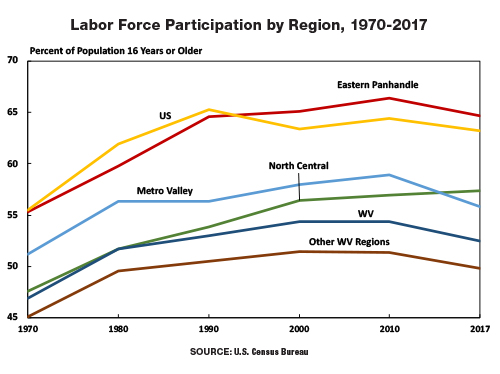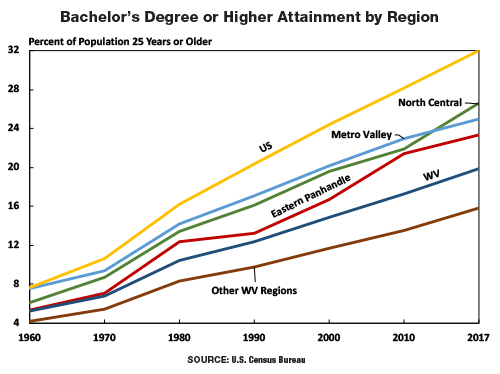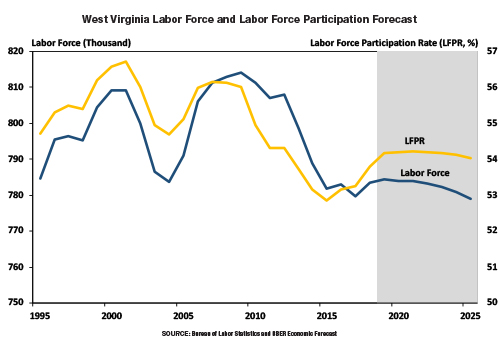By John Deskins
Since the beginning of 2017, West Virginia has made some important progress on its path to achieving the economic prosperity its citizens hope for. According to the Bureau of Labor Statistic’s Quarterly Census of Employment and Wages report, the state has added approximately 12,000 jobs over this period and has made progress along several other dimensions such as GDP, personal income and tax revenue.
Furthermore, unemployment in West Virginia is currently around 5 percent, which is low by any broad historic standard. This indicates that the state does not have a problem with a large number of its people looking for work unsuccessfully. If that’s true, what, then, is driving the state’s human capital shortage?

Labor Force Participation
Despite the recent progress and the state’s low unemployment rate, West Virginia’s most telling long-run statistic is its rate of labor force participation. This statistic captures the share of the adult population that wants to work in the first place, regardless of whether he or she has a job or is actively looking for work.
Consider these facts:
- Labor force participation in West Virginia is lowest among the 50 U.S. states, lagging the nation by 9 percentage points. Only 54 percent of adults in West Virginia are in the labor force.
- West Virginia has significantly lagged the nation in terms of labor force participation for decades—since at least 1940.
- The labor force participation gap between West Virginia and the nation is present broadly across genders and age groups and therefore cannot be attributed to one particular segment of the population. The Eastern Panhandle is the only region in the state that enjoys a higher rate of labor force participation than the nation. Otherwise, labor force participation tends to be higher in the more urban North Central and Metro Valley regions and lower in the state’s more rural areas.
This low rate of labor force participation represents one of the most severe impediments to economic progress in West Virginia as businesses that might potentially locate to or expand in West Virginia would likely be deterred by a lack of available, qualified workers. West Virginia will not be able to achieve the prosperity its citizens hope for until the state can find ways to get more of its men and women off the sidelines and into the labor force. This must be a top economic development priority.
Education
A key factor in explaining labor force participation in West Virginia is poor educational outcomes. It is likely that there are men and women who would like to work in an ideal world, but they do not look for work—and therefore are not part of the labor force—because they doubt they will be able to find a job due to a lack of education, training and job skills.
The problem is that West Virginia as a whole lags behind the nation in terms of education attainment, even though the state’s North Central, Eastern Panhandle and Metro Valley regions exhibit the highest rates of degree completion. The share of adult residents who hold at least a bachelor’s degree stands at 20 percent compared to 32 percent nationally, placing the Mountain State last in the country. To further complicate the situation, the number of high school and college-age men and women in West Virginia is shrinking, and the share of West Virginia high school graduates who go on to college has fallen slightly in recent years. The most recent year of available data—2017—shows only 55 percent of West Virginia high school graduates went on to college, compared to 67 percent in the nation. Altogether, these statistics suggest that it may become increasingly difficult to produce more highly educated and skilled young residents to attract potential businesses.

Drug Abuse and Health
In a similar vein, it is likely that there are men and women in West Virginia who would work but do not look for employment—and are not part of the labor force—due to some barrier related to drug abuse or health. West Virginia reports the highest mortality, disability and smoking rates among the 50 states, and it leads the nation in drug-related deaths. In 2017, 58 out of every 100,000 West Virginians died of drug misuse, a rate that is nearly triple the national figure. This affects economic development in a similar way as poor education outcomes: if potential businesses find it difficult to identify workers who are healthy and drug free, they are going to be disinclined to move to or expand their business in West Virginia.
Population and Migration
In studying the human capital challenge in West Virginia, the team at the Bureau of Business and Economic Research (BBER) at West Virginia University has reviewed the education, drug abuse and health elements as well as population and migration trends. The movement of people—especially working-age people—is also important in explaining labor force participation. By examining how demographic patterns evolve, the BBER is more likely to obtain a better sense of where potential businesses might be able to find an appropriate workforce and therefore identify which regions in the state potential businesses might be more attracted to.
Overall, West Virginia’s population has aged significantly over recent decades with high growth among the elderly population and virtually no growth in the prime working age population. The state’s Eastern Panhandle region is the clear outlier among the state’s various regions in that it has exhibited tremendous growth in recent decades, far surpassing national population growth. North Central West Virginia is the only other region in West Virginia to record population growth since 1980. Population growth in these regions is driven by both positive net migration and natural population growth, which is when births exceed deaths. West Virginia is consistently observing natural population decline where births fall short of deaths with the exception of these two regions.
In- and out-migration have also been volatile. Only the North Central and Eastern Panhandle regions have received substantial positive net migration flows in recent years. North Central West Virginia receives by far the largest number of net in-migrants from within West Virginia while the Eastern Panhandle receives by far the largest number of net in-migrants from other states.
Improving Labor Force Participation
What would it mean for West Virginia’s economy if the state found effective ways to increase labor force participation? To answer this question, the team at the BBER estimated the resulting long-run economic impacts from only a hypothetical 1-percentage-point increase in the labor force participation rate based on what are believed to be reasonable assumptions related to the time frame involved and the share of those entrants into the labor force who actually find jobs. A 1-percentage-point increase in labor force participation would only eliminate one-ninth of the gap between West Virginia and the nation, so this would not be a Herculean effort. According to the BBER’s estimates, bringing West Virginia men and women into the labor force so the rate improves by only 1 percentage point—and assuming only half of the men and women who enter the labor force actually obtain employment—this action would yield an increase of 11,000 jobs and more than $900 million in economic output annually.
These numbers indicate that this idea of increasing labor force participation by a single percentage point deserves serious attention. This information should inspire leaders across the state to push as hard as possible to find more effective ways to get more of West Virginia’s men and women into the workforce to make the state more attractive to potential businesses and more prosperous in the long run.









